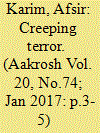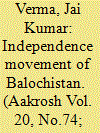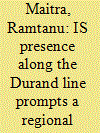|
|
|
Sort Order |
|
|
|
Items / Page
|
|
|
|
|
|
|
| Srl | Item |
| 1 |
ID:
150807


|
|
|
|
|
| Summary/Abstract |
The Islamic State of Iraq and the Levant (ISIL) may be forced to retreat
from Iraq-Syria under relentless pressure from forces allied with
Western powers, but the retreat is going to be painfully slow and
despite retreat, ISIL will be far from being finally defeated. If ousted
from west Asia, ISIL is likely to relocate in Africa and the Af-Pak and
launch new offensives. It is already gradually moving to the south
Asian region, which has the largest congregation of Sunni Muslims,
who support the ISIL ideology. South Asia will also provide ISIL greater
safety from Western forces and open opportunities to spread its
tentacles in various countries of the south and central Asian region. If
it eventually moves to south Asia in force, India will face a new,
dangerous challenge from Islamic forces.
|
|
|
|
|
|
|
|
|
|
|
|
|
|
|
|
| 2 |
ID:
150815


|
|
|
|
|
| Summary/Abstract |
In a bold departure from the old practice, Prime Minister Modi
made a reference to Balochistan, Gilgit and Baltistan in his
Independence Day speech; nonetheless the move was criticised
by the Pakistan government as well as by leaders of Indian
opposition parties. But the nationalist leaders of Balochistan
welcomed the move. The Khan of Kalat declared independence
and never wanted to be a part of Pakistan. Jinnah forcibly
merged Balochistan. The mineral-rich Balochistan is the biggest
province of the country, but it is the poorest region in south
Asia. The federal government, with an ulterior motive, is hindering
the progress of the province. The Pakistan government, instead
of redressing the legitimate problems of the province, alleges
that the insurgency in the state is fuelled by foreign powers.
Baloch leaders oppose the construction of the China-Pakistan
Economic Corridor (CPEC) as they fear that under the garb of
the CPEC, the Pakistan government would settle outsiders in
the state, which would change the demography of the province.
The Baloch leaders also mention that the CPEC is not in the
interest of the state. Pakistani forces have adopted the policy of
‘kill and dump’ to terrorise the Balochis.
Prime Minister Narendra Modi, in a momentous departure
from the old policy of defending India against Pakistani onslaught
about the human right violations in Kashmir, made a direct
reference to the Balochistan freedom movement, Gilgit and
Baltistan as well as Pakistan-occupied Kashmir from ramparts
of the Red Fort in his Independence Day speech of 15 August
2016.1
|
|
|
|
|
|
|
|
|
|
|
|
|
|
|
|
| 3 |
ID:
150819


|
|
|
|
|
| Summary/Abstract |
India’s internal security commitment in the North East is well
over the half-century-long mark. In J&K, it has gone beyond a
quarter of a century. In both cases, it can reasonably be argued
that there have been periods of quietude in which the peace
process could have been progressed to see a viable termination
of respective insurgencies. In neither case has this apparently
been possible. A consequence of political inattention to conflict
resolution has been a continuing deployment of the army under
an unpopular law, the Armed Forces (Special Powers) Acts
(AFSPA). It can be inferred that the belief underlying the status
quo is that the army can indefinitely sustain such deployment
and its effects.
Successive army chiefs have, usually while demitting office,
pointed out that this is an unsustainable belief. Internal security
duties have a long-term and deleterious effect on the army and,
therefore, they have urged political engagement in restoring
normalcy. However, the situation has remained largely unchanged.
There is even a danger of the army itself buying into the belief
that its deployment is indispensable to national integrity. An
argument could go that though there was some respite from
2004 onward in Kashmir, its disruption in 2008–2010 and more
recently this year, suggests that army deployment is inescapable.
Not all effects of such deployment are harmful, and those that
are can be mitigated by requisite leadership and training. The
army has sufficient depth in terms of numbers and moral resilience
to be able to sustain such deployment indefinitely – or so an
argument can go.
ALI AHMED
62 January 2017. Volume 20. Number 74. AAKROSH
This article argues that the assumption of the army’s ability
to sustain army deployment in a counter-insurgency role in
numerous states is fallacious. The army has to push back on the
internal argument that this is possible and to push on with
persuading the political leadership that democratic solutions
politically arrived at are the answer to the disaffection of people.
A lack of energy in a narrative along these lines is a pointer
that winning the argument for this internally will be probably
as difficult as selling it to the political class. The danger is in
the counter argument – of the army’s indispensability in militarily
propping up national integrity – making the army acquire a
stake in the disrupted security situation. It should not be that
institutional interests keep the army from a strong case arguing
for its return to barracks, where such distancing from an internal
security situation warrants it.
|
|
|
|
|
|
|
|
|
|
|
|
|
|
|
|
| 4 |
ID:
150813


|
|
|
|
|
| Summary/Abstract |
Locked in fierce battles with Russia, Iran, Syria and a
hesitant United States and trying to protect the territory
it seized in the Levant, the so-called Islamic State of
Iraq and Syria (ISIS) is losing ground rapidly. According
to an IHS Markit report released on 9 October, the
Islamic State’s caliphate shrank during 2015 from 90,800
km2 to 78,000 km2, a net loss of 14 per cent. And in
the first nine months of 2016, that territory shrank by
another 16 per cent. As of 3 October, the Islamic State
was left with control of roughly 65,500 km2 in Iraq and
Syria, an area roughly the size of Sri Lanka, the report
notes.
As the Syrian troops, under cover of heavy Russian
air attacks, have begun to close in on areas held by
ISIS and other rebel groups, it is likely that the socalled
Islamic State will continue to lose ground in the
coming months, stalling the group’s growth in that
region. Yet with thousands of fighters – most of whom
are Arabs, fortified by a large retinue of Caucasians
and central Asians and a smattering of fighters from
elsewhere – ISIS may shrink but is not likely to vanish.
Carrying black flags and promoting a hateful brand of
anti-Shi’a Islam, this virulent group could show up in
force in those Islamic countries where governance is
weak. One such location could be the Maghreb region
of north Africa; another is the virtually ungoverned
region that stretches between eastern and south-eastern
RAMTANU MAITRA
22 January 2017. Volume 20. Number 74. AAKROSH
Afghanistan and Pakistan’s Federally Administered
Tribal Area (FATA).
In fact, available ground reports indicate that
alleged followers of ISIS have already begun to appear
in eastern Afghanistan under the name of the Islamic
State in Khorasan Province (ISKP). Though they are
few in number, disunited and lacking both known
sponsors and known connections to ISIS at this time,
the emergence of these fighters over the past several
years seems to be prompting something of a realignment
in the greater south Asia region vis-à-vis the Taliban.
In particular, Iran, Pakistan, China, Russia and Kabul
appear to be converging around support for that
Pashtun-dominated terrorist grouping – which has been
viewed for more than a decade as the primary obstacle
to peace in war-torn Afghanistan by both Kabul and
its various allies – as a bulwark against the ISKP and
Islamic State inroads. What is going on? What is at
stake? What do these developments actually mean? For
answers, we need to take a much closer look.
|
|
|
|
|
|
|
|
|
|
|
|
|
|
|
|
| 5 |
ID:
150808


|
|
|
|
|
| Summary/Abstract |
Terrorists, irrespective of their country, class and culture, form
one community so far as their basic functions are concerned.
Primarily, they intend to wage a psychological war and strike
terror through assassinations or bomb explosions. The terrorists
also aim to inflict material destruction by destroying and
damaging the enemies’ utilities, communication networks and
industries, thereby attacking the economic structure of the
country. A government confronted with the terrorist challenge
may adopt a soft, compromising view on one hand and a tough
non-confessional authoritarian stand on the other. The result is
that many times, the public itself develops a hard, non-resistant
attitude towards the government for its apparently diffused
policies.
The Indian response to terrorism needs to reckon with
some of its structural inadequacies in order to evolve into an
effective strategy; primary among these are the psyche of a multiethnic
society that stands easily vulnerable to exploitation by
terror elements, which is even more accentuated by disparate
economic development in which poverty -stricken youth are often
hired to fight a war they have little to gain from.
|
|
|
|
|
|
|
|
|
|
|
|
|
|
|
|
|
|
|
|
|